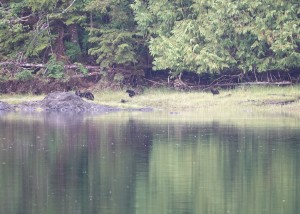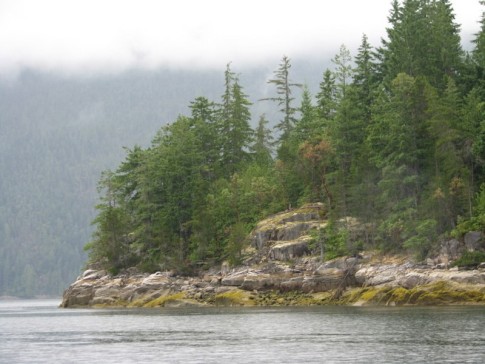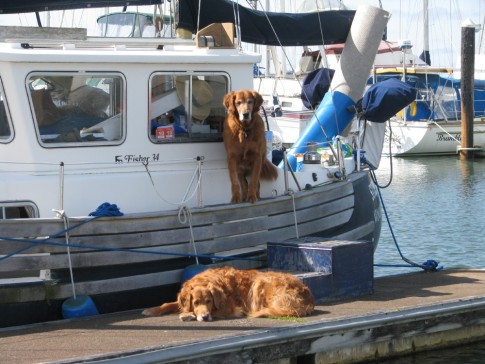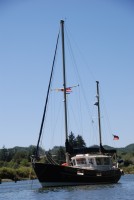Sirius Sailin'
| Vessel Name: | Storm Petrel |
| Vessel Make/Model: | Fisher 34 |
| Hailing Port: | Winchester Bay, Oregon |
| Crew: | Fraser and Jeff |
| About: | Additional Crew: Zac and Indy |
| Extra: | Storm Petrel is a 1977 Pilothouse ketch. She has sailed the Oregon/Washington coast since 1999, now home port is Pleasant Harbor, WA. |
30 September 2023
uly 24 - 25 A Rollicking Ride Down Hecate Strait to Cumshewa Inlet & Gordon Cove (53° 02.5’N, 132° 01.6’W) First Quarter Moon
The early morning was gorgeous! We got underway at 05:35 under thin, broken overcast skies with very light wind. The "Sleeping Beauty," a profile of a supine female form seen in the configuration of the mountain tops to the NW appeared navy blue in the early morning light. The gauzy white overcast was [...]
30 September 2023
July 23– Daajing Giids, Bearskin Bay, Queen Charlotte Harbor (53° 15.1’N, 132° 4.7’W) Waxing Cresent Moon
We left the marina by midafternoon with the intention of repositioning to the fuel dock adjacent to the marina in time to meet the attendant’s hours, 16:00-20:00 to this time of year. Before casting off the lines, we realized that the external regulator was not powered. Jeff did some troubleshooting [...]
30 September 2023
uly 21 – 22 Daajing Giids, Queen Charlotte Harbor (53° 15.2’N, 132° 4.4’W)
Although Jeff and I prefer to anchor out, being at a marina has advantages. It is easier to walk Zac and Indy at any time, engage in boat repairs and maintenance, explore the surrounding area, and of course, it is always nice to have a hot shower with plentiful water, that is, if one has enough “Loonies” [...]
Exploring the Inside Passage

One of the great delights of sailing along the Inside Passage is the abundance of wildlife. It is particularly thrilling to see humpback whales foraging not far from our boat when we're transiting the major sounds and channels, and to see them swim by the entrances to coves where we've anchored for the night. Their dark silhouettes stand out from the silvery water just after the sun has set behind the tree covered islands. Several times late at night we've heard their deep exhalations drift across the water, which adds to the delicious feeling of remoteness and tranquility of our anchorage. When the whales are busy foraging their breathing takes on a more rapid, forceful tempo and just before diving their inhalations sound a little like an elephant's bellow. Sometimes the whales seem to go into "stealth mode." They make very little sound as they briefly rise to the surface, their pairs of blowholes barely visible before they silently submerge. In stealth mode they don't exhale with a loud and vaporous blow nor do they gracefully arch their bodies with heart shaped flukes displayed before slipping beneath the surface, indicating a prolonged dive. Many of the whales we've stopped to watch are mother and calf pairs that swim in close proximity and in synchrony. Their exhalations are distinctive as the mother's bushy blow is so much taller than her calf's smaller cloud of breath. When we were fishing in Hakai Passage south of Hunter Island, we watched several whales engaged in exuberant fluke slapping. They looked like they were doing headstands under water with the length of their bodies from just below the dorsal fin to fluke towering in the air. They waved their flukes slightly forward and then sharply downward slapping the water hard and sending up a huge splash that could be seen at least a mile away. We also saw a couple of whales languidly waving one of their long pectoral fins in the air, the white undersides glinting in the sun, as if they were relaxed and just enjoying the calmer coastal waters.
Each cove or bay where we've anchored seems to have its resident bald eagles, often a pair or an adult and immature eagle, and a Pacific harbor seal or two. Many of the eagles we've seen are mottled brown and white in color, indicating that they are less than four years old and considered to be "immature." Sometimes the younger eagles hang-out together. We counted nine immature bald eagles sitting on a rock in Hakai Passage after having partaken in a feeding frenzy with hundreds of gulls all wanting their share of a herring ball. The eagles seem to have a much more challenging task than the gulls. Unlike gulls, which simply float on the water while consuming their meal, eagles have to swoop down and pick up a fish in their talons, gain altitude again while gripping the wriggling fish, and then find someplace to perch or stand before getting a chance to eat. If it's a small fish, the eagle may eat it on the wing. The spiraling ball of herring caught the attention of everyone in the vicinity, including us. Jeff caught a beautiful salmon in the same rich water. The lucky flasher that Jeff's friends at REACH 8 gave him lured the 8-pound silver salmon!
The harbor seals are charming to watch. While enjoying a couple of days in Target Bay, Nalau Passage (July 24-27), we were visited by a plump gray seal each morning. She seemed to have a couple of favorite basking rocks among the reefs along the NW side of the bay. Low tide exposed the rough, rather pointed rocks that looked a bit like a dragon's backbone. She managed to drape herself across one of the dragon's vertebrae and balance, looking comfortable with her body and flippers completely out of the water. She was wary, steadily sweeping her gaze behind toward the bay's entrance and in front of her toward Storm Petrel, but not shy. She allowed us to appreciate her sleek beauty and the pleasure of her company before sliding back into the clear, green water. She even let Fraser get her Nikon with 500mm lens out for a picture. On both days we didn't see her again until near dusk, when she fished within the bay.
Target Bay (we don't know the origin of the name, although other bays in the area were named during WWII, i.e., Spitfire Lagoon, Mustang Bay) was one of the anchorages where we saw and heard whales while at anchor. Several passed close to the entrance while we were reading in the cockpit and lazing in the hammock on the foredeck. We could occasionally hear them in the stillness of the wee hours of the star filled mornings. Nalau Passage is protected on all sides by tree covered hills and islands. It has a number of small bays off its main body and is connected to Queen Charlotte Sound through Hakai Passage, Edwards Channel, Ward Channels, and Fitz Hugh Sound. We didn't have any luck fishing or shrimping in Nalau Passage but the whales certainly seemed to find food within its boundaries. The entrance to Target Bay did yield a sweet red rock crab that we enjoyed for lunch. Jeff also caught a quillback rock fish in the crab trap, an unexpected delicacy.
We visited nearby Mustang Bay on one our explorations in the dinghy. It is a larger, more exposed bay than Target with a good-sized rocky island at its entrance. We look for such islands as they are places where the dogs can be off leash without fear of encountering bears or wolves. After the dogs swam, we all enjoyed lazing on the warm rocks and looking for treasures that washed up during winter storms. Fraser found an old wood fishing float caught in a depression in the middle of the island. It's pretty in a weathered, rustic way and holds a history about which we can only speculate. Who was the fisherman who used it to buoy his nets? How did it come to be lodged among the driftwood? Although rugged and exposed to wind and waves, the island has patches of grass and wildflowers, including wild strawberry plants and bright yellow common monkey flowers. While enjoying the warmth of the sun and beauty of the surrounding islands and water, we noticed a small humpback foraging in the bay. It took no notice of us but its presence immensely added to our pleasure.
Target Bay has two tree and salal covered islands near its entrance that were great dog exercise islands, especially at low tide when they almost doubled in size. Clusters of purple ochre stars were exposed by the receding tide, as were green sea urchins (the only place we've seen them), pacific blue mussels, acorn barnacles, and frilled dogwinkle. The salal was in bloom on the islands. It has pleasing bell-shaped pink flowers.
From Target Bay, we went to nearby Lewall Inlet (July 27-29), Stirling Island. Environment Canada predicted strong to gale force winds in Queen Charlotte Sound, so we wanted to find a good all-weather anchorage. Lewall Inlet is very protected and scenic. Lewall's resident eagle put on quite a pre-dinner show as it preened and groomed itself while perched on a snag overhanging the water near Storm Petrel. A pair of belted kingfishers was also entertaining as they very capably caught their dinners. These striking blue birds with spiky punk hairstyles are far too fast for picture taking from a distance.
The water is so calm in Lewall Inlet that it mirrors the lovely reflections of the surrounding trees. Unfortunately, the still air does nothing to deter the no-see-ums and mosquitoes which were fierce in the evening. We looked for the First Nations petroglyphs on the rocks on the south shore at the approach to the basin as recommended by Douglass & Douglass, in "Exploring the North Coast of British Columbia," but couldn't find them. On our dinghy ride through the L-shaped inlet we did see a wonderful school of moon jellyfish. We were fascinated by their pulsing ballet through the water and their uncanny ability to dive deeper when we got near enough to take a picture. Later that night, we had an opportunity to take pictures of another moon�"the earth's moon. Who knew that our Canon cameras could capture such vivid images of the moon's magnificence? The craters and shadows on the surface of the glorious quarter moon could be seen with the binoculars and with the assistance of digital magnification. Needless to say, the stars were also amazing as they sparkled in a sky undiminished by city lights!
On the second night we were in Wigham Cove (July 20 & 21), at the south end of Yeo Island, off Return Channel, north of Bella Bella, we were treated to another phenomenal sight in the night sky - the Northern Lights. It was thanks to Casey's culinary indiscretion (at least to our thinking) that we happened to be out on deck at 02:30. Wigham Cove has a large rocky islet in its center, perhaps a tenth of an acre, which was a superb place to exercise the dogs. Casey loves to dig for rocks, sticks, or whatever else he can recover from the shallows. He proudly hauls these prizes out of the water for us to see and then returns to excavate more. Unbeknown to us, he had switched from his usual passion and had started to eat the acorn barnacles exposed on the rocks at mid-tide. These white, volcano shaped barnacles crumble and easily peel off the rocks but their shells are sharp. When we shouted for him to stop, he only gobbled more as if he had discovered some great delicacy. Jeff finally had to escort him back to the dinghy and even then, Casey grabbed a bite or two on the way. Casey's digestive system could handle the creature's flesh, but not the shells and it began to rebel in the early morning hours. Thankfully, he safely regurgitated the shells and seemed to recover without complications. In the process of depositing the results of Casey's escapade over the side, we looked up and were surprised to see the northern sky illuminated by diaphanous, greenish-white sheets of light. The light waved and slowly pulsed in intensity from translucent to a more vivid white. We stood in the cockpit transfixed by the spectacle. The atmospheric conditions that morning also made the stars seem particularly close and utterly brilliant.
From Wigham Cove we went south to Fancy Cove (July 22-24), in Lama Passage. On the way, we stopped for a walk and provisions at the Band grocery store in Bella Bella. The town is also known by its First Nations name, Waglisa. The weather has been so dry this summer that we were not able to get water to fill our tanks while at the government dock. It was the same in Shearwater. Fortunately, we are very conservative in our water use. We estimate that we used 40 gallons in a two week period. The saltwater pump Jeff installed in our galley allows us to conserve fresh water for cooking, drinking, and a final rinse for dishes. We take showers in the cockpit, using our 5-gallon "sunshower" when the black-sided, plastic bag gets warm enough and the wind isn't blowing too hard. When the conditions are right there is nothing as refreshing as an outdoor shower, especially when some time has passed since the last one!
Fancy Cove was enchanting. We anchored behind an islet in the inner cove, which offered good protection and a marvelous view of Lama Passage to the north. We hoped to see the aurora borealis again but there was too much cloud cover by early morning. During our first evening in the cove, we were thrilled to see two bald eagles swooping low over the water to catch their dinners and later an osprey engaged in the same pursuit. The osprey stood tall in the branch of a nearby tree, looking like an elegant diner in a white shirt and dark jacket. The bird looked to the right and left repeatedly as it peered intently into the shallows below before it lifted off the branch and jetted toward its prey. The osprey was successful every time.
At the entrance to Fancy Cove is a small islet that beckoned to be explored. In our imaginations the islet undoubtedly was the home of another sea gnome. We visited at low tide when the shoreline was covered by yellow-brown rockweed, also called "popweed." The little bulbs of this ubiquitous plant float in the water and when dried by the sun and stepped upon, make a popping sound. Casey, Jake, and Kaela enjoyed retrieving sticks thrown into the water for them and discovering the intriguing scents left by river otters and other animals that had recently visited the islet. We all climbed into the soft, moss and lichen "nest" supported by the root system of the islet's dwarf red cedars.
At high tide, when the water reached up the rocks along the shore and seemed to tickle the branches of low hanging tree limbs, we rode in the dinghy to the cove next door. Tidal differences in this area are in the range of 16 feet. At the low, low tide in a twenty-four hour period the water in the adjacent cove completely receded. A belted kingfisher entertained us as we just sat in silence appreciating the serenity and admiring the shades of green in the forest and reflected in the water.
We noticed on the chart that there were three small lakes a short distance into the interior of Hunter Island. We took the dinghy over to the east side of Fancy Cove where a stream flowed into a grass covered marsh. Blazing a trail through the forest, we eventually found one of the brackish lakes. It was too clogged with fallen trees and weeds for a swim but very pretty. There were no signs that anyone other than wild creatures had been this way until on the way back to the dinghy we discovered a primitive trail probably used by other hikers. The windswept red cedar, hemlock, fir trees and salal that cover the islands create a beautiful scene. Nurse logs, fallen trees that support the growth of new trees and epiphytes, like ferns, mosses, and some lichens are everywhere.
We decided to head further south from Fancy Cove in order to be ready to cross Queen Charlotte Sound and Queen Charlotte Strait when an advantageous weather window appeared. Sailing down Fisher Channel and into Fitz Hugh Sound we enjoyed seeing more humpbacks, particularly as we neared Nalau Passage. It was just outside this passage at the southern tip of Hunter Island that we watched two whales cooperatively engaged in bubble net fishing. A third whale completely surprised us by surfacing close to our port side when we stopped to appreciate the others. The whale made a quick dive with a spectacular display of his or her flukes and then surfaced with the other whales some distance away. Fraser, sitting on deck, was so in awe of the magnificent whale, she didn't have the presence of mind to take a picture of the immense flukes as they towered in the air and then disappeared into the sea. The flukes would have completely filled the frame! We think the whale may have dived beneath Storm Petrel, which was coasting, out of gear; we can't be sure but we held our breaths for a moment or two.
We briefly visited Namu Harbour, the site of a thriving cannery in previous years. The cannery is now defunct and the buildings, houses, and surroundings have the air of a ghost town. The caretakers welcomed us upon our arrival and allowed us to fill our water tanks. We decided not to seek moorage, although it is available, because we wanted to find a more secluded place to anchor. We have become spoiled with the opportunity to be the only boat in a cove or bay. Had we not motored across Fitz Hugh Sound again we would have missed the memorable encounter with the humpbacks. Target Bay, our anchorage for the next three days, was wonderfully wild and scenic and offered the delights previously highlighted.




